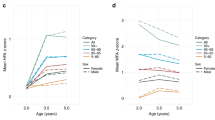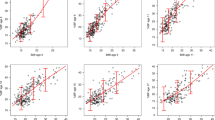Abstract
BACKGROUND:
Estimates of the prevalence of overweight and obesity in young people are typically based on body mass index (BMI). However, BMI may not indicate the level of central adiposity. Waist circumference has therefore been recommended to identify young people at risk of morbidity associated with central adiposity.
OBJECTIVE:
To investigate (a) change in total and central adiposity between 7–8 and 12–13 y (b) agreement between classifying young people as overweight or obese based on total adiposity and central adiposity, and (c) risk factors associated with the development of total and central adiposity.
DESIGN:
Anthropometric measurements were taken on 342 children in 1996/97 and 5 y later. Risk factors examined included birth weight, physical activity, TV viewing, pubertal status, parental adiposity, diet and socio-economic status.
RESULTS:
Between 7–8 and 12–13 y indices of central adiposity increased more than total adiposity; waist circumference z-score increased by (mean±s.d.) 0.74±0.92 and BMI z-score increased by 0.18±0.67. At 12–13 y there was moderate agreement between the two measures of adiposity (weighted kappa=0.64). However, waist circumference identified a greater number of young people as overweight or obese compared to BMI (41.2 vs 29.3%, P<0.001). Adiposity status at 7–8 y, maternal obesity, and pubertal stage were the strongest predictors of BMI status at 12–13 y. Risk factors associated with increased central adiposity were similar.
CONCLUSIONS:
Overweight and obesity, as measured by waist circumference, is a bigger problem than is currently assessed by BMI. Targeting known risk factors for total adiposity may be an appropriate strategy for preventing increased central adiposity.
This is a preview of subscription content, access via your institution
Access options
Subscribe to this journal
Receive 12 print issues and online access
$259.00 per year
only $21.58 per issue
Buy this article
- Purchase on Springer Link
- Instant access to full article PDF
Prices may be subject to local taxes which are calculated during checkout



Similar content being viewed by others
References
Maffeis C, Corciulo N, Livieri C, Rabbone I, Trifiro G, Falorni A, Guerraggio L, Peverelli P, Cuccarolo G, Bergamaschi G, Di Pietro M, Grezzani A . Waist circumference as a predictor of cardiovascular and metabolic risk factors in obese girls. Eur J Clin Nutr 2003; 57: 566–572.
Moreno LA, Pineda I, Rodriguez G, Fleta J, Sarria A, Bueno M . Waist circumference for the screening of the metabolic syndrome in children. Acta Paediatr 2002; 91: 1307–1312.
Whincup PH, Gilg JA, Papacosta O, Seymour C, Miller GJ, Alberti KG, Cook DG . Early evidence of ethnic differences in cardiovascular risk: cross-sectional comparison of British South Asian and white children. BMJ 2002; 324: 635.
Savva SC, Tornaritis M, Savva ME, Kourides Y, Panagi A, Silikiotou N, Georgiou C, Kafatos A . Waist circumference and waist-to-height ratio are better predictors of cardiovascular disease risk factors in children than body mass index. Int J Obes Relat Metab Disord 2000; 24: 1453–1458.
Taylor RW, Jones IE, Williams SM, Goulding A . Evaluation of waist circumference, waist-to-hip ratio, and the conicity index as screening tools for high trunk fat mass, as measured by dual-energy X-ray absorptiometry, in children aged 3–19 y. Am J Clin Nutr 2000; 72: 490–495.
Daniels SR, Khoury PR, Morrison JA . Utility of different measures of body fat distribution in children and adolescents. Am J Epidemiol 2000; 152: 1179–1184.
McCarthy HD, Ellis SM, Cole TJ . Central overweight and obesity in British youth aged 11–16 y: cross-sectional surveys of waist circumference. BMJ 2003; 326: 624.
Rodriguez G, Moreno LA, Blay MG, Blay VA, Garagorri JM, Sarria A, Bueno M . Body composition in adolescents: measurements and metabolic aspects. Int J Obes Relat Metab Disord 2004; 28 (Suppl 3): S54–S58.
Rudolf MC, Greenwood DC, Cole TJ, Levine R, Sahota P, Walker J, Holland P, Cade J, Truscott J . Rising obesity and expanding waistlines in schoolchildren: a cohort study. Arch Dis Child 2004; 89: 235–237.
Moreno LA, Fleta J, Sarria A, Rodriguez G, Gil C, Bueno M . Secular changes in body fat patterning in children and adolescents of Zaragoza (Spain), 1980–1995. Int J Obes Relat Metab Disord 2001; 25: 1656–1660.
Lobstein T, Baur L, Uauy R . Obesity in children and young people: a crisis in public health. Obes Rev 2004; 5 (Suppl 1): 4–104.
Davison KK, Birch LL . Childhood overweight: a contextual model and recommendations for future research. Obes Rev 2001; 2: 159–171.
Garnett SP, Cowell CT, Baur LA, Fay RA, Lee J, Coakley J, Peat JK, Boulton TJ . Abdominal fat and birth size in healthy prepubertal children. Int J Obes Relat Metab Disord 2001; 25: 1667–1673.
Norton K, Whittingham N, Carter L, Kerr D, Gore C, Marfell-Jones M . Measurement techniques in anthropometry. In: Norton K, Olds T (eds). Anthropometrica. Sydney: University of NSW Press; 1996.
http://www.cdc.gov/growthcharts/ Accessed November 2003.
McCarthy HD, Jarrett KV, Crawley HF . The development of waist circumference percentiles in British children aged 5.0–1.69 y. Eur J Clin Nutr 2001; 55: 902–907.
Frisancho AR . Anthropometric standards for assessment of growth and nutritional status. University of Michigan Pres Michigan, Ann Arbor; 1990.
Cole TJ, Bellizzi MC, Flegal KM, Dietz WH . Establishing a standard definition for child overweight and obesity worldwide: international survey. BMJ 2000; 320: 1240–1243.
World Health Organisation. Obesity: preventing and managing the global epidemic. Report of a WHO Consultation on ObesityWHO; Geneva; 1998.
Australian Bureau of Statistics. Census of Population and Housing, Household form. ABS: Canberra; 1991.
Department of Community Services: Health. Composition of foods, Australia. Australian Government Publishing Service: Canberra; 1995.
Duke PM, Litt IF, Gross RT . Adolescents' self-assessment of sexual maturation. Pediatrics 1980; 66: 918–920.
Weiss R, Dziura J, Burgert TS, Tamborlane WV, Taksali SE, Yeckel CW, Allen K, Lopes M, Savoye M, Morrison J, Sherwin RS, Caprio S . Obesity and the metabolic syndrome in children and adolescents. N Engl J Med 2004; 350: 2362–2374.
McCarthy HD, Jarrett KV, Emmett PM, Rogers I . Trends in waist circumferences in young British children: a comparative study. Int J Obes Relat Metab Disord 2005; 29: 157–162.
Whincup PH, Gilg JA, Odoki K, Taylor SJ, Cook DG . Age of menarche in contemporary British teenagers: survey of girls born between 1982 and 1986. BMJ 2001; 322: 1095–1096.
Demerath EW, Towne B, Chumlea WC, Sun SS, Czerwinski SA, Remsberg KE, Siervogel RM . Recent decline in age at menarche: the Fels Longitudinal Study. Am J Hum Biol 2004; 16: 453–457.
Freedman DS, Khan LK, Serdula MK, Dietz WH, Srinivasan SR, Berenson GS . Relation of age at menarche to race, time period, and anthropometric dimensions: the Bogalusa Heart Study. Pediatrics 2002; 110: e43.
Moreno LA, Fleta J, Mur L, Rodriquez G, Sarria A, Bueno M . Waist circumference values in Spanish children—gender related differences. Eur J Clin Nutr 1999; 53: 429–433.
Zannolli R, Morgese G . Waist percentiles: a simple test for atherogenic disease? Acta Paediatr 1996; 85: 1368–1369.
Fernandez JR, Redden DT, Pietrobelli A, Allison DB . Waist circumference percentiles in nationally representative samples of African-American, European-American, and Mexican-American children and adolescents. J Pediatr 2004; 145: 439–444.
2000 CDC Growth Charts for the United States. Methods and Development. www.cdc.gov/nchs/data/series/sr_11/sr11_246.pdf Accessed April 2005.
Gordon-Larsen P, Adair LS, Nelson MC, Popkin BM . Five-year obesity incidence in the transition period between adolescence and adulthood: the National Longitudinal Study of Adolescent Health. Am J Clin Nutr 2004; 80: 569–575.
Whitaker RC, Wright JA, Pepe MS, Seidel KD, Dietz WH . Predicting obesity in young adulthood from childhood and parental obesity. N Engl J Med 1997; 337: 869–873.
Katzmarzyk PT, Srinivasan SR, Chen W, Malina RM, Bouchard C, Berenson GS . Body mass index, waist circumference, and clustering of cardiovascular disease risk factors in a biracial sample of children and adolescents. Pediatrics 2004; 114: e198–e205.
Neovius MG, Linne YM, Barkeling BS, Rossner SO . Sensitivity and specificity of classification systems for fatness in adolescents. Am J Clin Nutr 2004; 80: 597–603.
Reilly JJ, Dorosty AR, Emmett PM . Identification of the obese child: adequacy of the body mass index for clinical practice and epidemiology. Int J Obes Relat Metab Disord 2000; 24: 1623–1627.
Magarey AM, Daniels LA, Boulton TJ, Cockington RA . Predicting obesity in early adulthood from childhood and parental obesity. Int J Obes Relat Metab Disord 2003; 27: 505–513.
Maffeis C, Talamini G, Tato L . Influence of diet, physical activity and parents' obesity on children's adiposity: a four-year longitudinal study. Int J Obes Relat Metab Disord 1998; 22: 758–764.
Burke V, Beilin LJ, Dunbar D . Family lifestyle and parental body mass index as predictors of body mass index in Australian children: a longitudinal study. Int J Obes Relat Metab Disord 2001; 25: 147–157.
Parsons TJ, Power C, Logan S, Summerbell CD . Childhood predictors of adult obesity: a systematic review. Int J Obes Relat Metab Disord 1999; 23 (Suppl 8): S1–S107.
Moore LL, Gao D, Bradlee ML, Cupples LA, Sundarajan-Ramamurti A, Proctor MH, Hood MY, Singer MR, Ellison RC . Does early physical activity predict body fat change throughout childhood? Prev Med 2003; 37: 10–17.
Acknowledgements
This study was funded by The Children's Hospital at Westmead Grant Research Scheme and a National Health and Medical Research Council Project Grant #206501. We thank all the families that generously donated their time to participate in this study.
Author information
Authors and Affiliations
Corresponding author
Rights and permissions
About this article
Cite this article
Garnett, S., Cowell, C., Baur, L. et al. Increasing central adiposity: the Nepean longitudinal study of young people aged 7–8 to 12–13 y. Int J Obes 29, 1353–1360 (2005). https://doi.org/10.1038/sj.ijo.0803038
Received:
Revised:
Accepted:
Published:
Issue Date:
DOI: https://doi.org/10.1038/sj.ijo.0803038
Keywords
This article is cited by
-
The acceptability, effectiveness, and impact of different models of care for pediatric weight management services: protocol for a concurrent mixed-methods study
BMC Health Services Research (2018)
-
Prevalence and geographic variation of abdominal obesity in 7- and 9-year-old children in Greece; World Health Organization Childhood Obesity Surveillance Initiative 2010
BMC Public Health (2017)
-
Zinc status, dietary zinc intake and metabolic risk in Australian children and adolescents; Nepean Longitudinal Study
European Journal of Nutrition (2017)
-
Prevalence and lifestyle determinants of central obesity in children
European Journal of Nutrition (2016)
-
Changes in adiposity indicators of Ho Chi Minh City adolescents in a 5-year prospective cohort study
International Journal of Obesity (2013)



